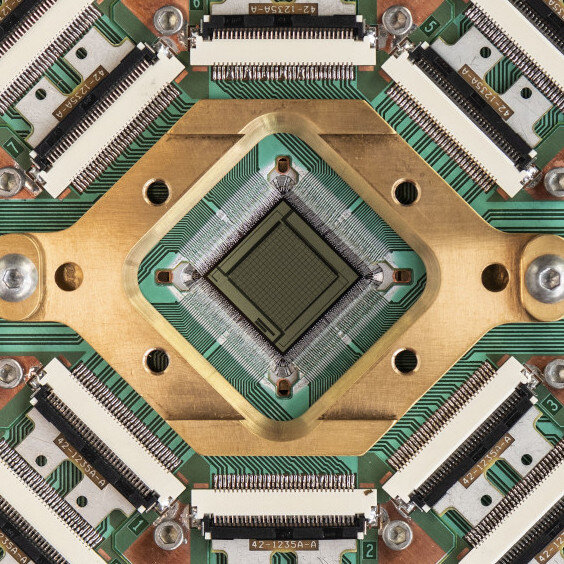
Over the past decades, researchers and companies worldwide have been trying to develop increasingly advanced quantum computers. The key objective of their efforts is to create systems that will outperform classical computers on specific tasks, which is also known as realizing “quantum advantage.”
A research team at D-Wave Quantum Inc., a Canadian quantum computing company, recently created a new quantum computing system that outperforms classical computing systems on optimization problems. This system, introduced in a paper in Nature, is based on a programmable spin glass with 5,000 qubits (the quantum equivalents of bits in classical computing).
“This work validates the original hypothesis behind quantum annealing, coming full circle from some seminal experiments conducted in the 1990s,” Andrew D. King, one of the researchers who carried out the study, told Phys.org.
“These original experiments took chunks of spin-glass alloy and subjected them to varying magnetic fields, and the observations suggested that if we made a programmable quantum spin glass, it could drive down to low-energy states of optimization problems faster than analogous classical algorithms. A Science paper published in 2014 tried to verify this on a D-Wave Two processor, but no speedup was found.”
In their recent work, King and his colleagues realized quantum acceleration by boosting the connectivity and coherence of the D-Wave Advantage processor, a quantum computing system recently developed at D-Wave. They ultimately pushed this processor into a coherent annealing regime with no thermal effects, which was not achieved in previous works.
To attain this, the researchers programmed a 5,000-qubit spin glass system that they could then control. They then used this system to tackle different optimization problems.
“This is a ‘full circle’ moment, in the sense that we have verified and extended the hypothesis of the UChicago and NEC researchers; quantum annealing shows a scaling advantage over simulated thermal annealing,” King said. “Ours is the largest programmable quantum simulation ever performed; reproducing it classically is way beyond the reach of known methods.”
To realize coherent annealing rigorously and reliably, the team first developed a 2,000-qubit system and applied it to a simple 1D problem that can be precisely solved with classical computing methods. In their new study, on the other hand, they developed a system with over double the number of qubits and applied it to a problem that cannot be simulated using classical computing tools.
“For several reasons, D-Wave annealing-based quantum computers are the only quantum platform that can solve this kind of optimization problem,” King said. “The first is size: we looked at scaling behavior from very small spin glasses (250 qubits) to very large (5,000+ qubits); 250 is pretty much the upper limit for other platforms. The second reason is programmability: we programmed qubit networks in a three-dimensional geometry, tuning each individual qubit-qubit interaction individually.”
The researchers performed their experiments on an online production system, which means that they could run alongside their cloud customer activities. In this online platform and with their 5,000-qubit spin glass system, they finally demonstrated scaling advantage on optimization problems.
“We have a clear view of quantum effects and very clear evidence, both theoretical and experimental, that the quantum effects are conferring a computational scaling advantage over classical methods,” King said. “We want to highlight the difference between this original definition of quantum advantage and the fact that it is sometimes used as a stand-in term for quantum supremacy, which we have not demonstrated. Gate-model quantum computers have not shown any capabilities approaching this for optimization, and I personally don’t believe they ever will.”
In light of their recent work, King and his colleagues believe that quantum annealing will always perform better than gate-model on optimization problems. This is why D-Wave is currently focusing on the development of both these platforms.
“For a long time, it was subject for debate whether or not coherent quantum dynamics were playing any role at all in quantum annealing,” King said. “While this controversy has been rebuked by previous works, this new research is the clearest demonstration yet, by far.”
The work by this team of researchers and the 5,000-qubit system they realized is a significant contribution to the field of quantum computing, which specifically highlights the potential of tackling optimization problems using quantum computing systems. Their recent paper focused on attaining quantum advantage over classical systems on optimization problems by precisely controlling the quantum dynamics of a large system. In their future works, however, King and his colleagues would also like to quantify how limited classical methods are and show that the capabilities of their system can reach beyond those of supercomputers.
“We can also see the effects of coherence in our processors very clearly,” King added. “The Advantage2 processor, currently in development, promises significant improvements in that area, so we’re really excited to see what we can do, not only in terms of improved optimization for customer applications, but also with more exotic experiments in coherent annealing.” https://phys.org/news/2023-05-team-quantum-advantage-optimization-problems.html







Recent Comments